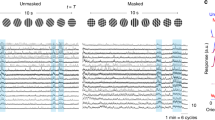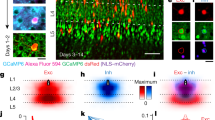Abstract
NEURONS in the primary visual cortex (VI) respond in well defined ways to stimuli within their classical receptive field, but these responses can be modified by stimuli overlying the surrounding area1–7. For example patch-suppressed cells respond to gratings of a specific orientation within their classical receptive field, but the response diminishes if the grating is expanded to cover the surrounding area1–7. We report here more complex effects in many such cells. When stimulated at their optimal orientation, introducing a surrounding field at a significantly different (for example, orthogonal) orientation enhanced their output by both a disinhibi-tory mechanism and an active facilitatory mechanism producing'supra-optimal' responses. Importantly, some cells responded well if the orientations of centre and surround stimuli were swapped. The output reflected the discontinuity because neither stimulus component alone was effective. Under these stimulus conditions simultaneously recorded cells with orthogonally oriented receptive fields showed correlated firing consistent with neuronal binding to the configuration. We propose a mechanism integrating orientation-dependent information over adjacent areas of visual space to represent focal orientation discontinuities such as junctions or corners.
This is a preview of subscription content, access via your institution
Access options
Subscribe to this journal
Receive 51 print issues and online access
$199.00 per year
only $3.90 per issue
Buy this article
- Purchase on Springer Link
- Instant access to full article PDF
Prices may be subject to local taxes which are calculated during checkout
Similar content being viewed by others
References
Maffei, L. & Fiorentini, A. Vision Res. 16, 1131–1139 (1976).
Fries, W., Albus, K. & Creutzfeldt, O. D. Vision Res. 17, 1001–1008 (1977).
Nelson, J. I. & Frost, B. J. Brain Res. 139, 359–365 (1978).
Gilbert, C. D. & Wiesel, T. N. Vision Res. 30, 1689–1701 (1990).
DeAngelis, G. C., Robson, J. G., Ohzawa, I. & Freeman, R. D. J. Neurophysiol. 68, 144–163 (1992).
Grinvald, A., Lieke, E. E., Frostig, R. D. & Hildesheim, R. J. Neurosci. 14, 2545–2568 (1994).
Born, R. T. & Tootell, R. B. H. Proc. natn. Acad. Sci. U.S.A. 88, 7071–7075 (1991).
Sillito, A. M. J. Physiol. 273, 791–803 (1977).
Orban, G. A., Kato, H. & Bishop, P. O. J. Neurophysiol. 42, 818–832 (1979).
Orban, G. A., Kato, H. & Bishop, P. O. J. Neurophysiol. 42, 833–849 (1979).
Ts'o, D. Y., Gilbert, C. D. & Wiesel, T. N. J. Neurosci. 6, 1160–1170 (1986).
Abeles, M. J. Neurosci. Meth. 5, 317–325 (1982).
Abeles, M. & Gerstein, G. L. J. Neurophysiol. 60, 909–924 (1988).
Palm, G., Aertsen, A. M. H. J. & Gerstein, G. L. Biol. Cybern. 59, 1–11 (1988).
Gray, C. M., König, P., Engel, A. K. & Singer, W. Nature 338, 334–337 (1989).
Engel, A. K., König, P., Gray, C. M. & Singer, W. Eur. J. Neurosci. 2, 588–606 (1990).
Gray, C. M., Engel, A. K., König, P. & Singer, W. Eur. J. Neurosci. 2, 607–619 (1990).
Bergen, J. R. & Julesz, B. Nature 303, 696–698 (1983).
Bergen, J. R. & Julesz, B. IEEE Trans. Syst. M13, 857–863 (1983).
Keeble, D. R. T., Kingdom, F. A. A., Moulda, B. & Morgan, M. J. Vision Res. 35, 1991–2006 (1995).
Hubel, D. H. & Wiesel, T. N. J. Neurophysiol. 28, 229–287 (1965).
DeAngelis, G. C., Freeman, R. D. & Ohzawa, I. J. Neurophysiol. 71, 347–374 (1994).
Knierim, J. J. & Van Essen, D. C. J. Neurophysiol. 67, 961–980 (1992).
Sillito, A. M., Cudeiro, J. & Murphy, P. C. Expl Brain Res. 93, 6–16 (1993).
Author information
Authors and Affiliations
Rights and permissions
About this article
Cite this article
Slllito, A., Grieve, K., Jones, H. et al. Visual cortical mechanisms detecting focal orientation discontinuities. Nature 378, 492–496 (1995). https://doi.org/10.1038/378492a0
Received:
Accepted:
Issue Date:
DOI: https://doi.org/10.1038/378492a0
This article is cited by
-
Cortico-cortical feedback engages active dendrites in visual cortex
Nature (2023)
-
Visual surround suppression at the neural and perceptual levels
Cognitive Neurodynamics (2023)
-
Cognitive penetrability of scene representations based on horizontal image disparities
Scientific Reports (2022)
-
Revisiting horizontal connectivity rules in V1: from like-to-like towards like-to-all
Brain Structure and Function (2022)
-
A bio-inspired spatiotemporal contrast operator for small and low-heat-signature target detection in infrared imagery
Neural Computing and Applications (2021)
Comments
By submitting a comment you agree to abide by our Terms and Community Guidelines. If you find something abusive or that does not comply with our terms or guidelines please flag it as inappropriate.



